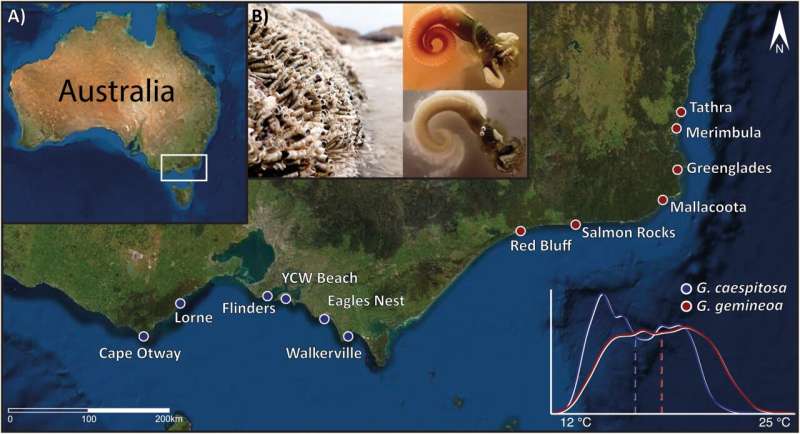This article has been reviewed according to Science X's editorial process and policies. Editors have highlighted the following attributes while ensuring the content's credibility:
fact-checked
peer-reviewed publication
trusted source
proofread
Climate change reveals intricate dynamics of reproductive barriers in marine species

Monash University scientists have uncovered insights into how rising temperatures influence the reproductive interactions and species boundaries of marine organisms.
As climate change continues to reshape ecosystems, a new study from the Faculty of Science at Monash University sheds light on the complex interplay between temperature, parental sex and reproductive barriers in marine tubeworms, known as Galeolaria, from southern Australia's fast-warming biodiversity hotspot.
Galeolaria tubeworms are foundation species found on the rocky shores of temperate Australia. The tubeworms build and occupy dense colonies of stony tubes, which enhance coastal biodiversity by providing habitat and refuge from heat stress for species that would not otherwise persist there.
The study, published in Evolution, was motivated by the fact that climate change is altering species ranges and interactions, providing species with new opportunities to mate and hybridize.
The research team examined a range of barriers to reproduction across the life stages of two Galeolaria species, spanning different temperature ranges from Cape Otway in Victoria all the way up to Tathra in New South Wales. This region is globally recognized for its marine biodiversity and is also warming much faster than the global average rate.
The findings indicate that reproductive barriers between the species are weaker at the fertilization and embryogenesis stage, but become stronger and more temperature-sensitive during the larval development stage.
Importantly, the study also reveals asymmetry in barriers between parental sexes, suggesting a complex interplay between thermal niche differentiation and maternal inheritance.
Senior author Dr. Keyne Monro from Monash University School of Biological Sciences explains, "Our research highlights the pivotal role of temperature in shaping reproductive isolation between species of Galeolaria. As temperatures rise, we observe shifts in the strength of reproductive barriers, with significant implications for the future dynamics of species interactions and biodiversity.
"Our findings point to a key role for temperature in reproductive isolation, but also challenges for predicting the fate of isolation in future climates."
The study underscores the importance of understanding the environmental and biological factors that influence reproductive isolation, particularly in the context of climate change.
By examining barriers across multiple life stages and environmental conditions, researchers can gain valuable insights into the mechanisms driving species sensitivities to climate and species hybridization.
"Our findings emphasize the need for comprehensive assessments of reproductive barriers across diverse environments," says co-author Associate Professor Kay Hodgins from the Monash University School of Biological Sciences.
"This knowledge is crucial for predicting the fate of species boundaries and guiding conservation efforts in a rapidly changing world.
"By unraveling the intricate relationship between temperature, reproductive barriers, and species interactions, scientists are better equipped to protect and preserve marine biodiversity in the face of environmental change," said Dr. Hodgins.
As marine ecosystems face unprecedented challenges from climate change, studies like this provide essential insights into the adaptive strategies and ecological dynamics of marine organisms.
More information: Cristóbal Gallegos et al, Temperature and sex shape reproductive barriers in a climate change hotspot, Evolution (2024). DOI: 10.1093/evolut/qpae012
Journal information: Evolution
Provided by Monash University





















